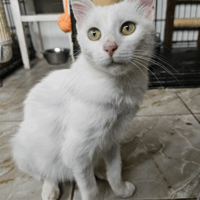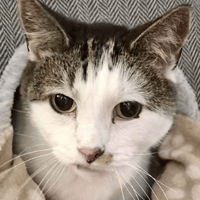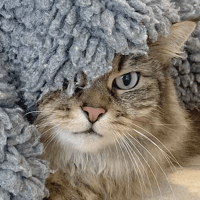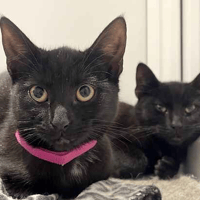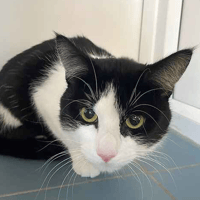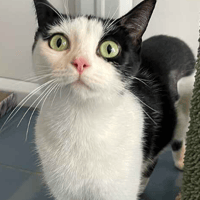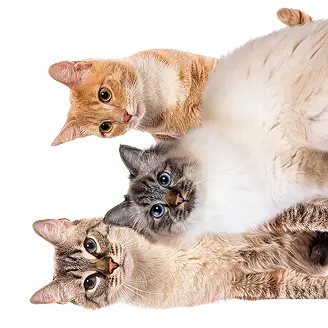Domestic shorthair


Legendary charm, silky fur, a mysterious gaze... Over the thousands of years following their domestication, the cat has become a staple companion, illuminating the lives of millions of humans around the world. Their intelligence, robustness and adaptability are certainly to thank for their biological success. Today, more than forty breeds are recognised by feline associations and they all have the common domestic cat as an ancestor.
That said, it is thanks to their diversity that the domestic cat has won the hearts of humans ... even the most hardened!
|
Life expectancy |
The Domestic shorthair has a life expectancy of between 13 and 17 years |
|
Adult size |
Female
Between 9 and 10 in
Male
Between 9 and 10 in
|
|
Adult weight |
Female
Between 4 and 9 lb
Male
Between 9 and 11 lb
|
|
Coat colour
Black / seal, blue / grey-slate, chocolate, lilac / lilac, cinnamon / cinnamon, fawn, white |
Black Brown White Blue |
|
Type of coat
Long, mid-length, short. |
Short Long |
|
Eye colour
Blue, aquamarine, green, golden yellow, dichroic eyes |
Blue
Green
Yellow
Odd-eyed
|
|
Purchase price |
The Domestic shorthair costs between £0 and £150 |
There are more than forty breeds of domestic cats. Today, the alley cat or moggy is more and more accepted in competitions organised by large feline associations. Note that many household cats may be of mixed breeds or have an ancestor with pedigree.
More details about the Domestic shorthair
Domestic shorthair: Origins and history
The Felis silvestris lybica cat was reportedly domesticated some 12,000 years to 4,000 years ago. The most early evidence of domestication dates from 9,500 years ago. Cats were reportedly attracted by the mice and other opportunistic animals that benefited from grain storage following early human agriculture. Gradually, the least fearful cats were selected to reproduce. There was not one, but many domestications of the cat, spread over a very long period. This process of domestication took place in the Middle East and North Africa.
Over time, a whole range of shapes, colours and personalities have been formed... to the delight of cat lovers!
Physical characteristics of the Domestic shorthair
Whether you like it in black or white, striped or plain, bushy or flat, practically any type of coat is possible for Moggies! Their cosmopolitan geographical distribution means that this common cat is found in almost all the regions of the world, with the exception of the northern and southern poles. Thus, particular biological traits may vary depending on the habitat of the cat, their living conditions and genetic background.
Domestic shorthair: Characteristics
Domestic shorthair: Behaviour
Breed compatibility Domestic shorthair
Domestic shorthair: Purchase price
The price of a common kitten is usually between £0 and £150. This price varies according to many factors: age, sex, appearance, etc. For the monthly budget, on average £25 / month is enough to meet their biological needs. In any case, it is vital to offer quality food and medical care to keep your cat healthy.
Domestic shorthair: Shedding
Average
Depending on the length of the coat, hair loss can be more or less significant.
Domestic shorthair: Grooming
If the cat has long hair, daily brushing is recommended, otherwise weekly maintenance of the coat is sufficient. Some individuals need their eyes and ears to be cleaned regularly. In these cases, it is important to be attentive to avoid the accumulation of secretions.
Domestic shorthair: Health
On average they tend to live for 13 to 17 years but many live for much longer. In some exceptional cases, cats have lived for over 30 years.
The alley cat is particularly resistant to changes in weather and extreme temperatures. They’re typically considered to be healthy and robust cats as long as their biological needs are met.
Several factors increase the risk of feline obesity, such as age, environment, diet and activity of the cat. As a general rule, the common cat does not get overweight if they are sufficiently active and have access to a balanced diet.
If all their needs are met, no particular disease is known, thanks to the great genetic diversity in the common cat. An annual medical check-up is nevertheless recommended, especially to ensure your cat’s oral health or any negative effects of aging.
However, they can develop the same illnesses as any other cat, such as oral diseases.
Obviously they can be bred with any breed of cat. The litters are usually of around 5 kittens.





